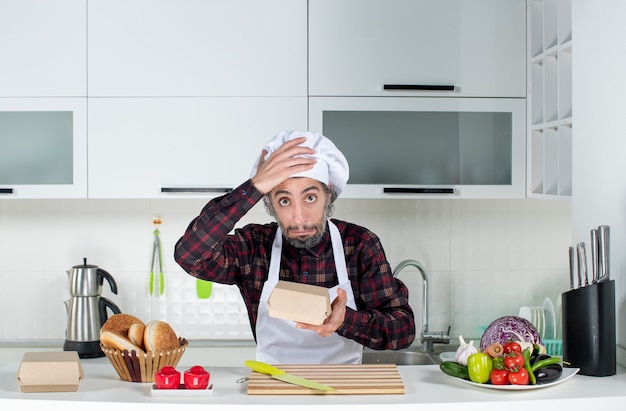Ah, lobster. The mere mention of the word conjures images of bright red shells, succulent, sweet meat, and a symphony of culinary delights. I’ve been a lobster enthusiast for years, dedicating countless hours to mastering the art of preparing these magnificent crustaceans. It's more than just chucking them in boiling water, you know. There's a real craft to it, a respect for the creature, and a desire to unlock its full flavour potential.
Today, I'm going to share my secrets – my ultimate guide to cooking lobster – so you can impress your guests, wow your taste buds, and experience the most delectable, tender, and juicy lobster imaginable.
(Part 1) The Lobster: Choosing Your Perfect Catch

1. Fresh is the Key
First and foremost, the foundation of any great lobster dish is freshness. Now, I know, a trip to the fishmonger isn't always feasible, but trust me, the difference in taste is astounding. fresh lobsters are lively, bursting with energy, their eyes bright and black, their shells firm and springy. Avoid those that are sluggish, with dull, cloudy eyes or a mushy feel.
2. Size Matters, But Don't Be Afraid to Go Big
When it comes to size, there's no one-size-fits-all rule. For a satisfying meal for two, lobsters weighing around 1.5 pounds are ideal. However, if you're feeling adventurous or feeding a crowd, don't shy away from larger lobsters, even those exceeding 3 pounds. The extra meat will be a welcome addition to your feast.
3. Male vs. Female: A Delicate Difference in Flavour
You might be surprised to learn that there's a subtle difference in taste between male and female lobsters. Male lobsters tend to be more meaty, while females are known for their delicate, sweet flavour. It's a matter of personal preference, really. I, for one, am partial to the sweeter, more delicate flavour of the female. But hey, you can always try both and see which you prefer.
(Part 2) Preparing Your Lobster: A Humane Approach

1. The Importance of Humane Dispatch
This is where things get a little more sensitive. Before cooking, you need to humanely dispatch the lobster. I know, it might sound daunting, but it's the kindest and most ethical thing to do. Here's my tried-and-true method:
1. Chill it out. Place the lobster in the fridge for about 30 minutes. This helps relax the lobster and minimizes any potential distress.
2. The swift, decisive strike. Use a very sharp knife and make a swift, decisive cut through the lobster's head, right behind the eyes. This is the most humane method, ensuring a quick and painless end.
3. Check for life. After the strike, there should be no movement or twitching. If there is, repeat the process to ensure a quick and humane end.
2. Cleaning Your Lobster: From Shell to Tail
Once you've humanely dispatched the lobster, it's time to clean it. This part is straightforward:
1. Remove the rubber bands. These are usually used to hold the claws together during transportation.
2. Clean the claws. Give them a good rinse under cold water and remove any dirt or debris.
3. Clean the body. Rinse the body thoroughly, paying attention to the crevices and under the tail.
(Part 3) The Boiling Method: A Classic for a Reason

1. The Boiling water bath: Simple and Effective
Boiling is a tried-and-true method, simple, reliable, and perfect for a quick and satisfying meal. Here's the breakdown:
1. A pot big enough for the occasion. Use a large pot that can comfortably hold the lobster, with enough water to cover it completely.
2. Bring the water to a rolling boil. Don't rush to add salt yet; we'll get to that in a minute.
3. Gently lower the lobster into the boiling water. Ensure it's fully submerged.
4. Salt for flavour. Now's the time to add salt. A good rule of thumb is one tablespoon of salt for every 2 quarts of water. This enhances the lobster's flavour.
5. Cook time is crucial. For a 1.5 pound lobster, cook for 10-12 minutes, maintaining a rolling boil.
2. Signs of a Perfectly Cooked Lobster: Don't Overcook
How do you know when it's ready? Here are some telltale signs:
1. The shell turns a vibrant red. It'll be a bright, rich red, indicating the heat has penetrated the shell.
2. The meat turns opaque. It will go from translucent to white, signaling it's cooked through.
3. The claws are easy to pull. When you gently tug on them, they should pull away easily, indicating the meat is tender.
(Part 4) The Steaming Method: A Gentle Approach to Lobster
1. The Steaming Process: Preserving Delicate Flavour
Steaming is a gentler method, preserving the lobster's delicate flavour and moisture. It's a bit more involved, but the result is worth the effort.
1. Get your steamer going. Fill the bottom of a steamer pot with about an inch of water. Place a steamer basket on top.
2. Aromatic additions for a complex flavour. If you like, you can add aromatics to the water, enhancing the flavour profile. A few bay leaves, sprigs of thyme, or a slice of lemon are excellent choices.
3. Add the lobster with care. Place the lobster in the steamer basket, making sure it's not overcrowded.
4. Cover and steam to perfection. Cover the steamer pot and bring the water to a boil. Then reduce the heat and steam the lobster for 10-12 minutes for a 1.5 pound lobster.
2. Steaming Tips: Don't Overdo It
Here are a few pointers for steamy success:
1. Avoid overcrowding the steamer. This can lead to uneven cooking.
2. Undercook rather than overcook. It's better to err on the side of undercooking, as the meat will continue to cook slightly after it's removed from the steamer.
3. Let it rest for optimal tenderness. Allow the lobster to rest for a few minutes before serving. This allows the heat to distribute evenly, resulting in more tender meat.
(Part 5) The Grilling Method: Smoky, Savoury Delights
1. Grilling Your Lobster: A Charred, Smoky Flavour
Grilling introduces a smoky, charred flavour to the lobster, adding a whole new dimension to its deliciousness.
1. Preheating your grill. Heat your grill to medium-high heat.
2. Prepping your lobster. Split the lobster in half lengthwise, using a sharp knife. You can also leave it whole if you prefer.
3. Seasoning is key. Brush the lobster with olive oil and season liberally with salt and pepper. For an extra flavour boost, add other spices or herbs like garlic powder, paprika, or parsley.
4. Grill time. Place the lobster on the preheated grill, flesh side down, and cook for 5-7 minutes. Flip it over and cook for another 5-7 minutes, or until the flesh is opaque and the shell is charred.
2. grilling tips: Keep It Simple
Here are some grilling tips to ensure a successful grilling experience:
1. Clean your grill grates. Use a grill brush to clean your grill grates before grilling, preventing sticking.
2. Flip it only once. Frequent flipping can dry out the lobster.
3. Adjust the heat as needed. Keep an eye on the heat and adjust it to avoid burning the lobster.
(Part 6) The Baking Method: Simple, Versatile, and Customizable
1. Baking Your Lobster: A Customizable Approach
Baking offers a simple, versatile approach, allowing you to customize the flavour with different sauces and toppings.
1. Preheating the oven. Preheat your oven to 400°F (200°C).
2. Preparing the lobster. Place the lobster in a baking dish, making sure it's not overcrowded. You can leave it whole or split it in half.
3. Seasoning for added flavour. Brush the lobster with olive oil and season generously with salt and pepper. For a more complex flavour profile, add herbs, spices, or even a lemon butter sauce.
4. Bake until perfection. Bake for 15-20 minutes, or until the flesh is opaque and the shell is bright red.
2. baking tips: Moisture and Temperature
Here are some baking tips to enhance the baking experience:
1. Add moisture to prevent dryness. Place a small amount of water or broth in the bottom of the baking dish to prevent the lobster from drying out.
2. Use a baking thermometer. Check the internal temperature of the lobster to ensure it's cooked through. The internal temperature should reach 140°F (60°C).
3. Let it rest for even heat distribution. Once the lobster is cooked, let it rest for a few minutes before serving. This allows the juices to redistribute and the meat to become more tender.
(Part 7) The Ultimate Lobster Sauce: Butter, Garlic, and Herbs
1. The Magic of Butter: A Rich, Creamy Base
Now, let's talk about the sauce. Lobster begs for a rich, buttery sauce that elevates its flavour to new heights. Here's my go-to recipe:
1. Melt the butter. In a saucepan, melt about 1/2 cup of unsalted butter over medium heat.
2. Add the garlic. Add 2-3 cloves of minced garlic and cook until fragrant, about 30 seconds.
3. Herbs for added complexity. Stir in 1 tablespoon of chopped fresh parsley, 1 teaspoon of chopped fresh thyme, and a squeeze of lemon juice.
4. Season to taste. Season with salt and pepper to taste.
2. Serving the Sauce: Hot and Delicious
1. Drizzle it on. Once your lobster is cooked, generously drizzle the sauce over it.
2. Serve it hot. The sauce is best served hot, so don't let it sit for too long.
3. Dip it in. You can also serve the sauce on the side for dipping.
(Part 8) Serving Your Lobster: A Feast for the Senses
1. Presentation Matters: Showcasing Your Creation
Now that you've got your perfectly cooked lobster, it's time to showcase it beautifully. There's nothing quite like a stunningly presented dish to make your guests feel special.
1. Crack the claws. Use a nutcracker to crack the claws.
2. Twist the tails. Twist the tail to separate the meat from the shell.
3. Plate with care. Arrange the lobster meat on a platter or individual plates.
4. Garnish for visual appeal. Add a sprig of parsley, a squeeze of lemon, or a sprinkle of paprika for a touch of elegance.
2. Lobster Pairings: Elevate the Experience
Lobster is a versatile dish that pairs well with a range of side dishes. Here are a few ideas:
1. Classic sides. Roasted vegetables, creamy mashed potatoes, and a simple salad work beautifully.
2. Bold choices. Risotto, pasta, or even a hearty bread are fantastic choices.
3. A touch of sweetness. A light fruit salad or a dessert wine can add a sweet contrast to the richness of the lobster.
(Part 9) FAQs: Your Lobster Cooking Questions Answered
1. The Allure of lobster bisque: A Creamy, Decadent Soup
Lobster bisque is a creamy, decadent soup made with lobster stock, cream, and often sherry or brandy. It's a real crowd-pleaser and perfect for a special occasion. You can find many recipes online, but my favourite uses a combination of fresh and cooked lobster meat for extra flavour.
2. Freezing Lobster: A Guide for Preserving Freshness
You can freeze lobster, but it's best to freeze it raw. Cooked lobster tends to become rubbery when frozen. To freeze raw lobster, wrap it tightly in plastic wrap and then place it in a freezer-safe bag. It will last for up to 3 months.
3. Reheating Lobster: Gentle Methods for Avoiding Rubberiness
Reheating lobster is tricky, as it can easily become dry and rubbery. The best way is to steam it gently, or place it in a baking dish with a little bit of water or broth and bake it in a preheated oven until it's warmed through.
4. Identifying Bad Lobster: Smell, Eyes, and Texture
Fresh lobster has a sweet, mild scent. If it smells fishy or ammonia-like, it's gone bad. You should also check the eyes. Fresh lobster eyes will be clear and black. If they're cloudy or milky, the lobster is no longer good to eat. Finally, check the texture. A fresh lobster will have a firm, springy shell, while a bad lobster will have a mushy, soft shell.
5. Lobster Shell: Edible, But Not Always Appealing
The shell is edible, but it's mostly made of chitin, which is a tough, fibrous substance that's not easily digestible. While there's no harm in eating it, most people find it too chewy and prefer to just eat the meat.
(Part 10) The Lobster Love Affair Continues
There you have it – my ultimate guide to perfect lobster preparation. It's a journey that begins with selecting the freshest catch, continues with humane handling, and culminates in a delicious, unforgettable meal. I hope this guide empowers you to embrace the art of lobster cooking and enjoy the richness, sweetness, and pure indulgence that this exquisite creature offers.
So, what are you waiting for? Go forth and conquer the world of lobster! And remember, the best recipes are always those we make with passion and a bit of love. Bon appétit!
Everyone is watching

How to Cook Frozen Lobster Tails Perfectly: A Step-by-Step Guide
RecipesLobster. Just the word conjures up images of lavish meals, special occasions, and a taste of luxury. But let's...

Pigs in a Blanket Cooking Time: How Long to Bake for Perfect Results
RecipesAh, pigs in a blanket. Just the name conjures up images of those delightful little parcels of crispy pastry en...

Pork Fillet Cooking Time: How Long to Cook It Perfectly
RecipesPork fillet, or tenderloin as it's sometimes called, is a real favourite in our house. It's so versatile, and...

The Ultimate Guide to Cooking Delicious Frankfurters
RecipesLet's face it, we all love a good frankfurter. It's a classic, simple, and always satisfying. But let's be rea...

Wolf Meat Recipes: A Guide to Cooking Wild Game
RecipesLet's be honest, you don't see wolf meat at your local butcher shop every day. It's a bit of a wild card, but ...
